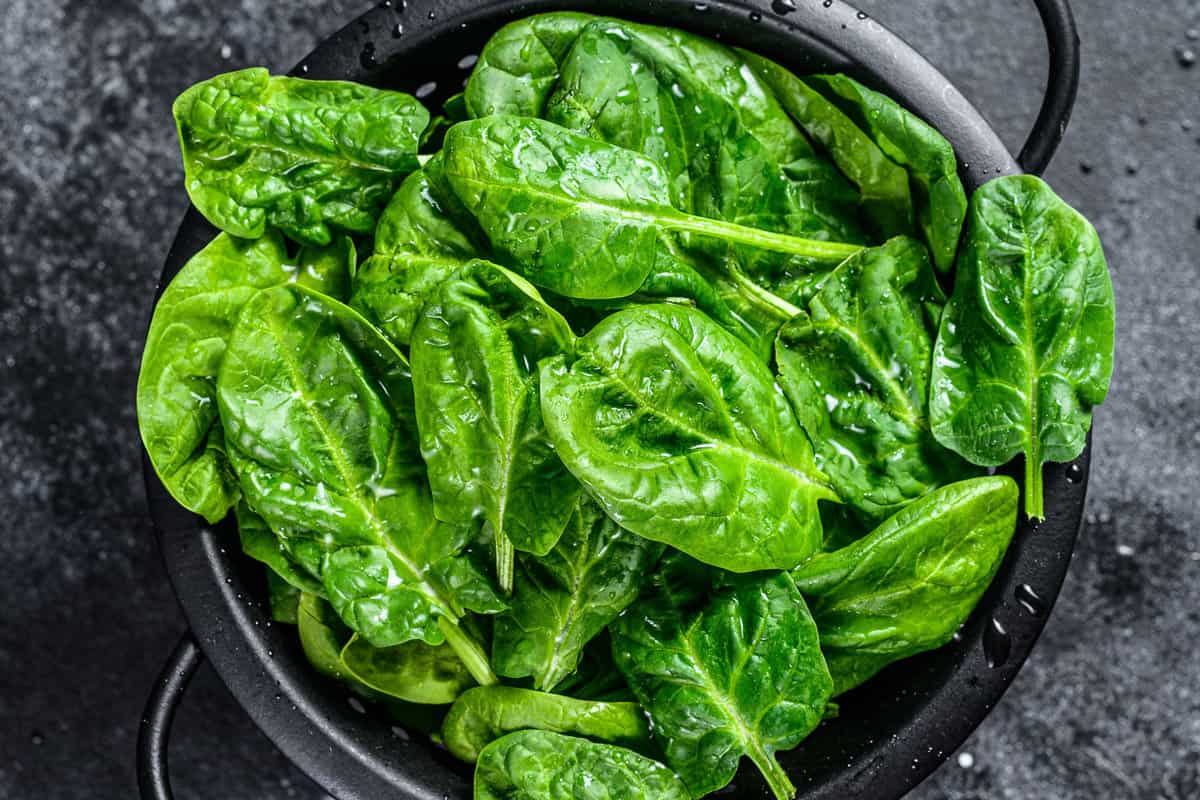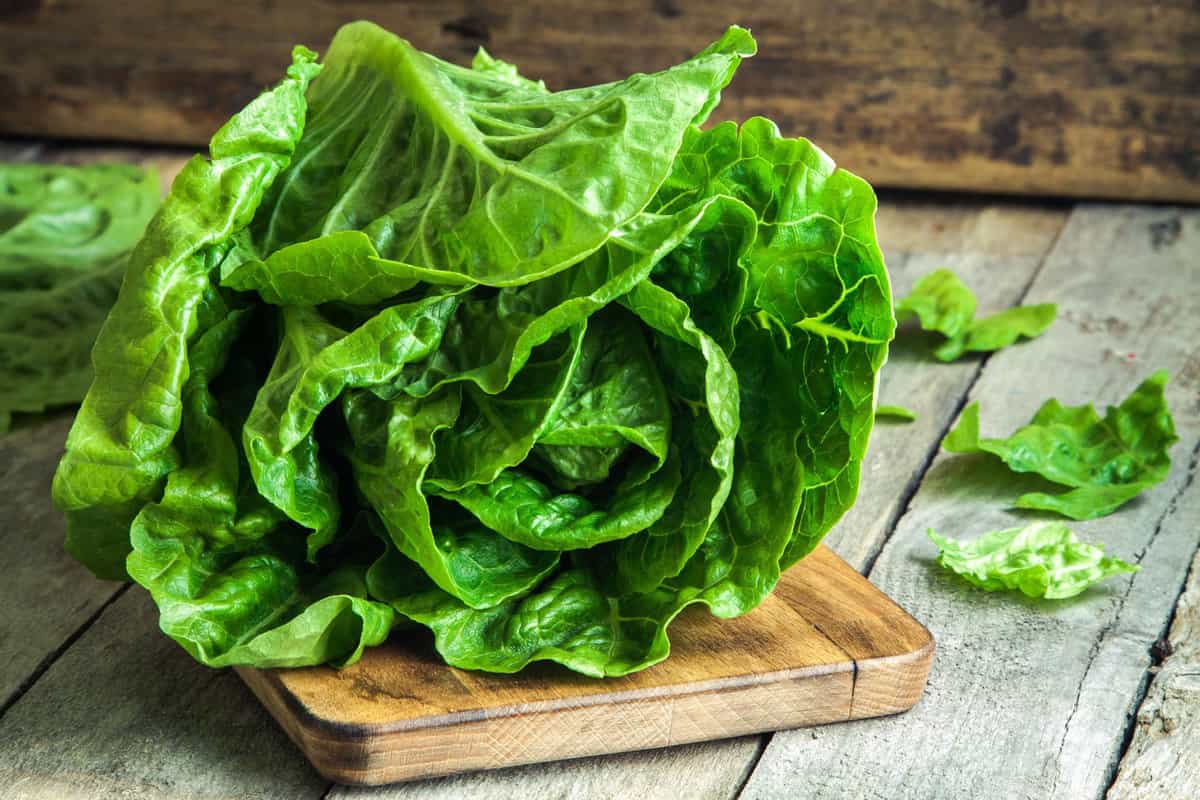While romaine lettuce and spinach may seem similar at first glance, they each bring their own distinct taste, texture, and nutritional benefits to the table.

So, which leafy green reigns supreme for your health?
The answer is...both!
Incorporating a variety of leafy greens into your diet is key to achieving optimal nutrition and health.
Try mixing romaine lettuce and spinach in your salads, sandwiches, and smoothies for a delicious and nutritious boost.
But before we get ahead of ourselves, let's dive into what makes these two similar - but different!
Romaine Lettuce Vs Spinach: An Overview
When it comes to choosing between romaine lettuce and spinach, it can be a tough decision. Both are nutritious leafy greens that offer a variety of health benefits.

However, there are some differences between the two that may make one more suitable for your needs than the other.
Romaine lettuce is a type of lettuce that is commonly used in salads and sandwiches. It has a crunchy texture and a slightly bitter taste. It is a good source of vitamins A, C, and K, as well as folate and potassium.
Romaine lettuce is also low in calories and carbohydrates, making it a great option for those looking to lose weight or maintain a healthy diet.
On the other hand, spinach is a versatile leafy green that can be eaten raw or cooked. It has a mild flavor and a tender texture. Spinach is a good source of vitamins A, C, and K, as well as iron, calcium, and fiber.
Spinach is also low in calories and carbohydrates, making it a great option for those looking to lose weight or maintain a healthy diet.
When comparing the two, spinach has more nutritional value than Romaine Lettuce.
Spinach contains more protein, fiber, vitamin B6, folate, riboflavin, niacin, magnesium, phosphorus, potassium, iron, copper, calcium, and zinc than Romaine Lettuce.
However, Romaine Lettuce has more vitamin A, pantothenic acid, and fewer calories, carbohydrates, and total fat than Spinach.
Both romaine lettuce and spinach are nutritious leafy greens that offer a variety of health benefits. While Spinach has more nutritional value, Romaine Lettuce is lower in calories and carbohydrates.
Ultimately, the choice between the two will depend on personal preference and individual nutritional needs.
The Growing Conditions
Growing Romaine Lettuce
Romaine lettuce is a cool-season crop that prefers temperatures between 60-65°F.
It can be grown in both spring and fall, but it is important to avoid planting it during the hottest months of the year.
Romaine lettuce requires a lot of sunlight, but it also needs partial shade to avoid bolting. Planting mini-Romaines is a great way to avoid bolting.
They will mature before the heat becomes too much.

Romaine lettuce grows best in well-draining soil that is rich in nutrients. It requires both nitrogen and soil moisture to grow quickly, so it is important to fertilize or amend the garden soil with plenty of compost.
Salad connoisseurs believe romaine grown in soil tastes better than hydroponic lettuce.
It is important to avoid planting romaine lettuce in the midday sun. Limiting sun exposure to Romaine lettuce plants will result in tastier, more leafy crops.
It is also important to keep the soil consistently moist, but not waterlogged. Overwatering can lead to root rot, which can kill the plant.
For more information, read here: What Temperature Is Too Hot For Lettuce? Cracking The Cool-Weather Crop Code!
Growing Spinach
Spinach is a cool-season crop that prefers temperatures between 50-60°F. It can be grown in both spring and fall, but it is important to avoid planting it during the hottest months of the year.
Spinach requires a lot of sunlight, but it also needs partial shade to avoid bolting.
Planting spinach in succession every two weeks can help ensure a continuous harvest.
Spinach grows best in well-draining soil that is rich in nutrients. It requires both nitrogen and soil moisture to grow quickly, so it is important to fertilize or amend the garden soil with plenty of compost.
Spinach prefers a soil pH between 6.0 and 7.0.
Spinach is also susceptible to fungal diseases, so it is important to water the plants at the base and avoid getting the leaves wet.
In addition, it is important to space the plants out to allow for good air circulation.
For more information, check out this feature: 11 Most Common Lettuce Pests You Need To Watch Out For
What pests or diseases commonly affect romaine lettuce and spinach?
Romaine lettuce and spinach are both susceptible to a range of pests and diseases that can impact their growth and quality.
Common Pests
Aphids
These small insects feed on plant sap and can distort leaves and transmit viruses.
Caterpillars
Various caterpillar species, such as cutworms and loopers, can chew on leaves and damage plants.
Leafminers
These tiny larvae tunnel through the leaves, leaving winding trails that can reduce the plant's ability to photosynthesize.
Slugs and Snails
These mollusks can feed on young lettuce and spinach plants, causing holes and damage to leaves.
Whiteflies
Similar to aphids, whiteflies feed on plant sap and can spread diseases while causing leaf yellowing and reduced growth.
Thrips
Thrips can damage leaves by scraping the surface and feeding on plant cells, leading to discolored, distorted, and scarred leaves.
Common Diseases
Downy Mildew
This disease causes yellowing and browning of leaves, often with a grayish fungal growth on the undersides of leaves.
Powdery Mildew
Powdery mildew appears as white powdery spots on the upper surface of leaves, causing reduced photosynthesis and overall plant health.
Fusarium Wilt
A soil-borne disease that leads to wilting, yellowing, and stunting of plants. It can cause significant damage to entire crops.
Botrytis (Gray Mold)
This fungal disease can cause brown spots on leaves and fruits, leading to rot and decay.
Bacterial Leaf Spot
Circular, water-soaked lesions with yellow halos can develop on leaves due to this bacterial infection.
Verticillium Wilt
Another soil-borne disease that causes wilting, yellowing, and death of foliage. It can affect the entire plant or individual branches.
Root Rots
Various fungal pathogens can cause root rot, leading to poor plant growth, wilting, and even death.
Preventing and managing these pests and diseases often involves a combination of cultural practices, such as proper spacing, crop rotation, and adequate irrigation, as well as using organic or chemical controls when necessary.
Regular scouting and monitoring of plants can help catch issues early and minimize their impact on the crop.
How fast do romaine lettuce and spinach grow from seed to harvest?
The growth rate of romaine lettuce and spinach from seed to harvest can vary depending on factors such as environmental conditions, variety, and cultivation practices.
Romaine Lettuce
Romaine lettuce seeds usually germinate within 5 to 10 days after planting.
Its seedlings are typically ready to be transplanted into the garden or larger containers after about 3 to 4 weeks from germination.
Additionally, romaine lettuce can be harvested in approximately 55 to 70 days from the time of planting the seeds.
Spinach
Spinach seeds typically germinate within 7 to 14 days after planting.
Its seedlings are generally ready for transplanting or thinning after about 3 to 4 weeks from germination.
Baby spinach leaves can be harvested in as little as 25 to 40 days after planting. For mature spinach leaves, the harvest time is usually around 45 to 60 days.
It's important to note that these timeframes are approximate and can vary based on factors like temperature, sunlight, soil quality, and care practices.
How many times should romaine lettuce and spinach be harvested? Do both allow for multiple cuttings?
Romaine lettuce and spinach are both leafy greens that can be harvested multiple times through a process called "cut and come again."
This means that instead of harvesting the entire plant at once, you can selectively pick the outer leaves while allowing the inner leaves to continue growing.
This allows for multiple harvests from the same plant, extending the overall harvest period.
For romaine lettuce
Romaine lettuce can typically be harvested multiple times by picking the outer leaves as they reach a desirable size.
You can start harvesting outer leaves once they are large enough to use.
Leave the central, inner leaves intact so they can continue growing. Depending on the growing conditions and care, you can usually get several harvests from a single romaine lettuce plant.
For spinach
Spinach is another leafy green that lends itself well to multiple harvests. Similar to romaine lettuce, you can harvest spinach by picking the outer leaves first, allowing the inner leaves to keep growing.
Spinach tends to bolt (produce flowers and seeds) relatively quickly in warm weather, which can make the leaves turn bitter, so it's best to harvest regularly and keep the plant from bolting to extend the harvest period.
It's important to keep in mind that the exact number of harvests you can get from each plant will depend on various factors including the specific variety of lettuce or spinach, growing conditions, climate, and how well you care for the plants.
Regularly watering, providing adequate nutrients, and preventing pest infestations are all important factors in maximizing the number of harvests you can get from your plants.
Culinary Uses
Romaine Lettuce in Cuisine
Romaine lettuce is a versatile ingredient that is used in many different dishes. It is a popular choice for salads, sandwiches, and wraps.
The leaves are crisp and have a slightly bitter taste, which makes them perfect for adding texture and flavor to a variety of dishes.
In addition to being used in salads, romaine lettuce can also be grilled or roasted. This gives it a smoky flavor and makes it a great addition to grilled meats or vegetables.
It can also be used as a substitute for bread in sandwiches or as a wrap for tacos or burritos.
Romaine lettuce is also a great source of vitamins and minerals. It is high in vitamin A, vitamin C, and folate, which makes it a healthy choice for any meal.
Spinach in Cuisine
Spinach is another versatile ingredient that is used in many different dishes. It has a mild flavor and can be eaten raw or cooked.
It is a popular choice for salads, sandwiches, and wraps.
Spinach is also a great addition to soups and stews. It adds color and flavor to the dish and is a great way to add some extra nutrients to your meal.
Spinach can also be sautéed or steamed and served as a side dish.
In addition to being a great source of vitamins and minerals, spinach is also high in antioxidants. This makes it a healthy choice for any meal.
In Closing
Ultimately, the choice between romaine lettuce and spinach comes down to personal preference and nutritional needs.
Both greens offer a wide range of vitamins and minerals that can help promote a healthier body.
